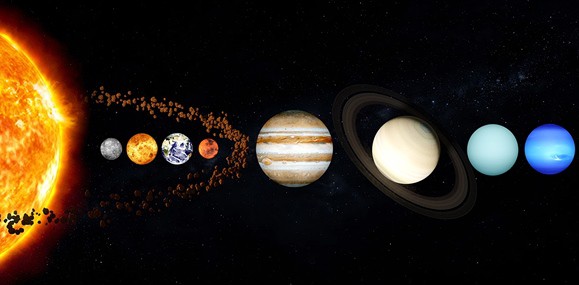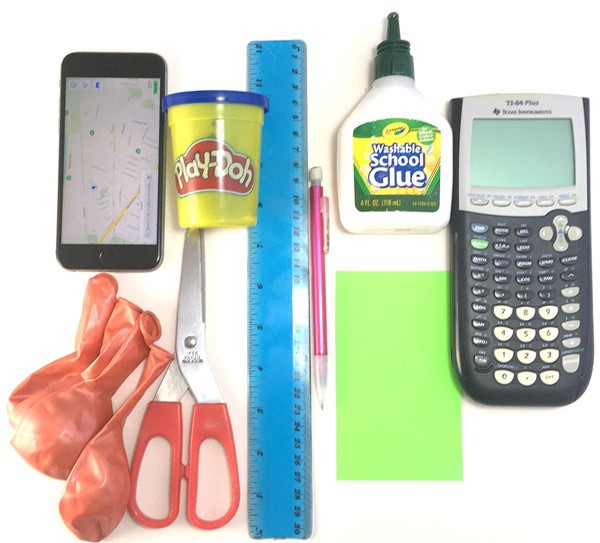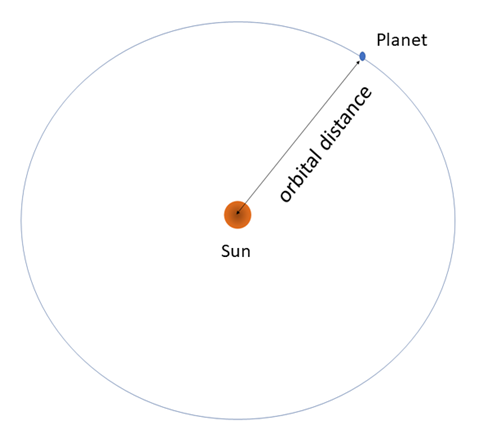Make a Model of the Solar System
Summary

Overview
This hands-on science lesson will help your students get a more accurate view of the solar system by making a scale model. They will do the calculations, make model planets, and find out where to place them so their model reflects reality. Seeing the relative size of the eight planets and their distance from the Sun displayed before them will allow your students to grasp the structure and vastness of the solar system.Learning Objectives
- Calculate the size of a model planet and its distance to the Sun when the actual measurements of the planet and the scale factor is given.
- Calculate the scale factor when the actual measurements of the solar system and the model are given.
- Learn facts about the solar system, such as the number of planets in the solar system, the small size of the planets compared to the size of the solar system, that all planets of the solar system orbit the Sun, etc.
NGSS Alignment
This lesson helps students prepare for these Next Generation Science Standards Performance Expectations:- MS-ESS1-3. Analyze and interpret data to determine scale properties of objects in the solar system.
|
Science & Engineering Practices
Developing and Using Models.
Develop a model to predict and/or describe phenomena.
Using Mathematics and Computational Thinking. Use mathematical representations to describe and/or support scientific conclusions and design solutions. |
Disciplinary Core Ideas
ESS1.B: Earth and the Solar System.
The solar system consists of the sun and a collection of objects, including planets, their moons, and asteroids that are held in orbit around the sun by its gravitational pull on them.
|
Crosscutting Concepts
Scale, Proportion, and Quantity.
Time, space, and energy phenomena can be observed at various scales using models to study systems that are too large or too small.
|
Materials
 Image Credit: Sabine De Brabandere, Science Buddies / Science Buddies
Image Credit: Sabine De Brabandere, Science Buddies / Science Buddies
For the class:
- Tape or glue to attach labels to the planets
- Spare balloons
For each group of four students:
- Play dough - store bought or homemade (2– 3 oz)
- Balloons (4)
- Metric ruler
- Cardstock to make labels for the planets
- Scissors
- Pen or pencil
- Calculator
- Map application on an electronic device or printed map of the nearby area (an area of 10 miles by 10 miles should suffice). Some map apps allow you to download a map in advance, so students do not need internet access to use that map.
Background Information for Teachers
This section contains a quick review for teachers of the science and concepts covered in this lesson.The solar system is the system of objects that orbit the Sun directly (e.g. the planets) or indirectly (e.g. Earth's moon). A celestial body is considered a planet in the solar system if it orbits the Sun, if it is heavy enough for gravity to squeeze it into a spherical shape, and if it has "cleared the neighborhood" around its orbit. The latter means that there are no objects comparable in size in the vicinity of its orbit, other than the planet's moons. Eight objects in the solar system qualify as planets: Mercury, Venus, Earth, Mars, Jupiter, Saturn, Uranus, and Neptune. Dwarf planets, like Pluto, fulfill the first two criteria, but not the last. Planets are not self-luminous—they do not emit light like the stars—but they can be seen in the sky because they reflect light emitted by other celestial objects.
Planets are approximately spherical, and the equatorial radius is often used as a measure of their size. The orbital distance is the average distance from the planet to the Sun as it circles the Sun. The distance from the Sun to a planet is not constant since the orbits are elliptical, but a circular orbit with the orbital distance as radius is a good approximation. The orbital distance is often expressed in astronomical units (AU). One AU equals roughly the distance from the Sun to Earth, or 149,597,870,691 ± 30 meters. Table 1 lists the radii and the orbital distances of the eight planets of the solar system.
 Image Credit: Sabine De Brabandere, Science Buddies / Science Buddies
Image Credit: Sabine De Brabandere, Science Buddies / Science Buddies
Figure 1. Drawing illustrating the definition of orbital distance.
| Planets | Radius (km) | Orbital distance (AU) |
|---|---|---|
| Mercury | 2,440 | 0.387 |
| Venus | 6,052 | 0.723 |
| Earth | 6,378 | 1.000 |
| Mars | 3,387 | 1.524 |
| Jupiter | 71,492 | 5.203 |
| Saturn | 60,268 | 9.537 |
| Uranus | 25,559 | 19.191 |
| Neptune | 24,764 | 30.069 |
Listed in increasing orbital distance from the Sun, we first encounter Mercury, the smallest of the eight planets. Mercury is only slightly larger than Earth's moon. Next is Venus, a planet with a radius of 6,052 km, only slightly smaller than Earth. Then comes Earth, the planet with the highest average density (5.5 g/cm3), followed by Mars. Mars' radius is about half of Earth's radius. It is a dusty, cold planet, but might have inhabited some form of life long ago. These first four planets are called the inner planets because they orbit closest to the Sun; they are also known as the rocky planets because their surfaces are rocky, showing mountains, valleys, and other formations. The rocky planets are all smaller than the gas planets and they are made of denser material. The next four—Jupiter, Saturn, Uranus and Neptune—orbit farther away from the Sun; they are gaseous planets. Jupiter is the largest, with a radius 11 times larger than Earth's radius; followed by Saturn, whose radius is about 9.5 times larger than Earth's radius. Saturn is the planet with the lowest density (0.7 g/cm3), a density so low that it would float if placed in water! Uranus and Neptune are similar in size, with a radius of 4.0 and 3.9 times the radius of Earth, respectively.
To make a scale model, your students should scale all the distances (radii and orbital distances) by the same factor, called the scale factor. For example, to create a scale model of the eight planets, scaled so the radius of Earth is 1 cm, you use a scale factor of 1 cm/6,378 km because 6,378 km (the actual radius of Earth) multiplied by 1 cm/6,378 km (the scale factor) yields 1 cm (the radius of the Earth model). You can find the radius of each of the other seven model planets by multiplying each planet's actual radius by the scale factor.
Table 2 lists the radii for this model and Figure 2 shows the results. Your students will make similar model planets. Because the radius of the Sun is about 109 times the radius of Earth, the Sun would have a radius of a little over 1 m in this model.
 Image Credit: Sabine De Brabandere, Science Buddies / Science Buddies
Image Credit: Sabine De Brabandere, Science Buddies / Science Buddies
Figure 2. Scale model of the eight planets of the solar system.
| Planet | Actual Radius (km) | Model Radius (cm) |
|---|---|---|
| Mercury | 2,440 | 0.38 |
| Venus | 6,052 | 0.95 |
| Earth | 6,378 | 1.00 |
| Mars | 3,387 | 0.53 |
| Jupiter | 71,492 | 11.21 |
| Saturn | 60,268 | 9.45 |
| Uranus | 25,559 | 4.01 |
| Neptune | 24,764 | 3.88 |
The planets' radii are small compared to their distance from the Sun, and it takes a little more work to calculate how far from the Sun these model planets need to be placed to get an accurate representation of the solar system. Orbital distance is often expressed in AU, so the first step is often to calculate what distance in the model corresponds to 1 AU in the real world. As 1 AU is approximately 150 million km, or 1.5 × 108 km, and 1 km converts to (1/6,378) cm, 1 AU will become 235,183 cm or about 235 m in your model. The scale factor 1 m/6,378 km thus becomes 235 m/1 AU. This is the same factor, only expressed in different units. Next, your students should multiply the orbital distance (in AU) of each planet by the scale factor (235 m/1 AU in this case) to find how far from the Sun the planets need to be placed in the model. Table 3 lists the results for a model where Earth is represented by a sphere with a radius of 1 cm.
| Planet | Actual Orbital Distance (AU) | Model Orbital Distance (m) |
|---|---|---|
| Mercury | 0.387 | 91 |
| Venus | 0.723 | 170 |
| Earth | 1.000 | 235 |
| Mars | 1.524 | 358 |
| Jupiter | 5.203 | 1,223 |
| Saturn | 9.537 | 2,241 |
| Uranus | 19.191 | 4,510 |
| Neptune | 30.069 | 7,066 |
You will likely not have space to lay the model planets out in the classroom, nor on the school grounds. Students can, however, use a map of their surroundings to visualize the scaled-down planet distances. They can use a printed map or an electronic application, like Google Maps. If you prefer a model where the solar system fits in the classroom, try the activity Model the Distances between Planets in our Solar System. Unfortunately, when scaling the solar system that much, the planets become too small to be visible.




